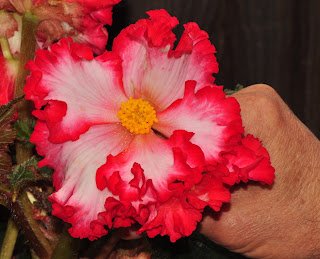Rebutias purchased at a friendly plant show - the Central Coast Cactus & Succulent Society of SLO.
And after only a few years - I find it's the same with birders! In both my lives in California (Santa Barbara County 2005 - 2009 and San Luis Obispo County 2011 - ?) there have been supportive, active, amusing and sharp bird folks. And it's also no good unless shared. The Yahoo Groups SBCObirding and SLOCObirding are very connecting, alerting many to special and often very transitory birds.Which brings me to being happy with cross bills, or better - Red Crossbills. Late morning today I read that Red Crossbills had been seen near the Interpretive Center at Montana de Oro State Park, only about five miles from where I live - and seventeen miles from where I was seated at work. Thirty-four miles round-trip, pick up my wife, find the bird, drop off Jeanne and back to work in a late hour for lunch? NO worries!
We found the birds right away, watched them for nearly fifteen minutes, then back to work. It made me very happy to see crossbills - a new bird for me!
A male and two female Red Crossbills
Look close for the crossing bills.
They were actively feeding on the Monterey Cypresses, with thousands of mature, reddish-brown, spherical cones.
You can imagine how the scissoring of crossed bills would easily tear into a closed cone.
Click on any photo to view larger images of all photos in this post.

.JPG)

.JPG)
.JPG)
.JPG)





.JPG)
.JPG)
.JPG)
.JPG)
.JPG)
.JPG)
.JPG)
.JPG)
.JPG)
.JPG)
.JPG)
.JPG)
.JPG)
.JPG)
.JPG)
.JPG)
.JPG)
.JPG)
























